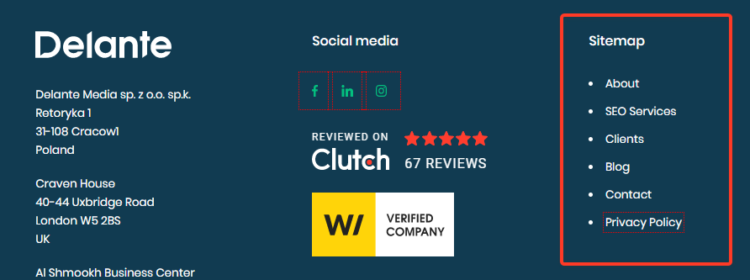Sitemap – What Is It and How to Configure It?

Are you a website owner wondering how to improve page visibility and indexing? This challenge is frequently faced by online stores with numerous subpages. Creating a sitemap isn’t a complex task and it can help you in the process.
A sitemap, most often in the form of the sitemap.xml file, is simply a map created to facilitate navigation of search engine robots. It contains all URLs of subpages of a given website.
Besides, a sitemap can be a source of extra information such as the last update of subpages and maps of videos and images available on the page.
Actually, it’s worth keeping in mind that creating such a file isn’t a guarantee that all subpages on your website will be indexed. However, this solution undoubtedly helps to facilitate the process. Another advantage that makes the implementation of a sitemap beneficial is the fact that this way you can inform the search engine that you’re the first creator of given content. Google wants to prevent duplicate content and thanks to the sitemap it’ll be provided with the exact time and date when you published your texts.
Types of sitemaps
There are a number of sitemaps, but the most popular ones include HTML and XML files. Let’s check out their characteristics and differences between individual types:
- HTML: a sitemap version created specifically for users of a given page. It’s a kind of table of contents that facilitates website navigation and makes it easier to find necessary subpages. A properly developed sitemap can also positively affect UX as Google appreciates user-friendly pages.
- XML: a sitemap with a different structure dedicated for Google robots. It’s a collection of subpages and information on URLs. Apart from other data, it provides details such as dates of the recent updates of subpages, the validity/priority of the URLs and the frequency of their modifications.
A sitemap is one of the components of technical SEO that plays a significant role in the entire SEO process. The sitemap aims mainly at making it easier for Google robots to navigate your page. Theoretically speaking, a sitemap isn’t a necessity, however, it can bring you numerous benefits. You should become interested in this subject especially if you own a complex page – thanks to the sitemap robots will be able to index the most relevant subpages significantly quicker.

.xml sitemap generation and configuration
If you’ve already decided that you need a sitemap, let’s discuss its creation and configuration. First of all, most CMSes make it possible to implement a sitemap. For example, WordPress, Shoper, Drupal or PrestaShop are equipped with their own systems that enable automatic sitemap generation.
However, if you want to do it on your own, Google created a recommended list of sitemap generators:
https://code.google.com/archive/p/sitemap-generators/wikis/SitemapGenerators.wiki
The generation of such a file isn’t complex, but it’s necessary to remember a few aspects. They’ll be useful if you need to create the sitemap from scratch or verify it later on:
- Add URLs of subpages that are up to date. Don’t take into account redirects and 404 errors as in this case, Google robots may have a negative impact on your site.
- Make sure that URLs correspond to specific subpages, e.g. https://delante.pl/ – correct; https://www.delante.pl/ – incorrect.
- Avoid using special characters and capital letters. The sitemap is created with UTF-8 encoding and there are text editors with this type of extension. If you use forbidden characters, Google robots may misinterpret such a subpage that consequently won’t be indexed or will generate 404 errors.
- Remember that a sitemap can include up to 50 000 URLs and its maximum size amounts to 50MB. This rule was created to prevent spam. If your website isn’t in line with these restrictions, it’s worth splitting the sitemap into a few smaller ones. This creates a sitemap index that indicates the location of all the map files on your website. They can be classified similarly to the sitemap.
- It’s important to take into account all language versions of your page. Therefore, the URL of each language should be placed in the sitemap and marked with the hreflang attribute. To learn more, go to our entry: Foreign market entry success – with new domains or language versions?
- It’s worth updating the sitemap every time you change addresses of subpages and add or remove specific URLs,
- Last but not least – a key principle without which the entire process doesn’t make any sense – submit the sitemap to Google Search Console. This way, search engine robots will notice and index it quickly. In the panel, you can check if the sitemap is correct and how many URLs have been indexed.
You can check out your sitemap by entering this in the search bar:
If all the data is entered correctly, you’ll see the content of the entire file. However, in case of any errors you either won’t see the content or you’ll see a 404 error saying that the specified page wasn’t found.
Sometimes, depending on the website, the sitemap may look differently: https://mywebsite.com/sitemap, https://mywebsite/page-sitemap.xml, etc.
It’s worth taking a look at guidelines prepared by Google Search Console: https://developers.google.com/search/docs/advanced/sitemaps/overview?visit_id=637554571929511457-4218586658&rd=1. This way, creating a sitemap should be a piece of cake. Additionally, you can take advantage of the support available at https://www.sitemaps.org/ and obtain answers to relevant questions.
Google sitemap and its impact on SEO
A sitemap has a significant impact on the SEO process. Thus, it’s worth having it (and adding it to Google Search Console) before you start performing SEO activities. A sitemap is extremely helpful in internal linking which is one of the important components of the SEO process.
b
As we’ve mentioned above, the sitemap file affects website visibility. Thanks to it, search engine robots can see the entire page structure and navigate it easily. This way, the probability of the site being indexed and displayed in higher positions in the search results increases. Of course, improved page visibility equals improved traffic. Users will be able to access your website quickly and if you create the html sitemap as well, it’ll be easier for them to move around the page.
Remember that your sitemap needs to be updated in order to work properly and provide you with all the potential benefits.





